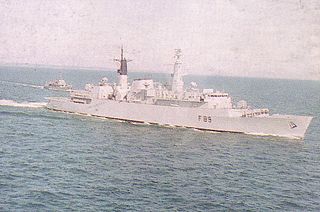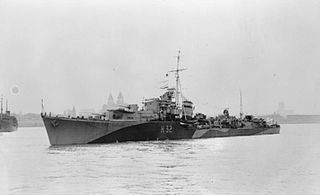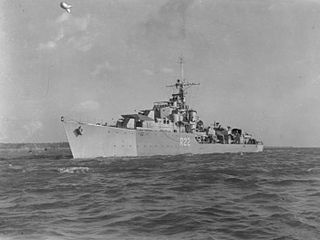
HMS Battleaxe was a Type 22 frigate of the British Royal Navy. She was sold to the Brazilian Navy on 30 April 1997 and renamed Rademaker.

HMS Barrosa (D68) was a later or 1943 Battle-class fleet destroyer of the Royal Navy.

HMS Corunna (D97) was a later or 1943 Battle-class fleet destroyer of the Royal Navy. She was named in honour of the Battle of Corunna, which took place during the Peninsular War in 1809 between British and French forces. Corunna was built by Swan Hunter & Wigham Richardson Limited on the Tyne. She was launched on 29 May 1945 and commissioned on 6 June 1947.

The Weapon class was a class of destroyers built for the British Royal Navy towards the end of World War II. They were the smaller counterpart to the Battle class and were the first new destroyer designs for the Royal Navy since the Second World War Emergency Programme. 20 ships were planned, of which only 13 were laid down and 7 were launched, but the cessation of hostilities resulted in only 4 being completed for service. Two of the ships had been previously ordered as part of the planned C class, or 15th Emergency flotilla, of 1944, but the orders were changed to the new design.

The C class was a class of 32 destroyers of the Royal Navy that were launched from 1943 to 1945. The class was built in four flotillas of 8 vessels, the "Ca", "Ch", "Co" and "Cr" groups or sub-classes, ordered as the 11th, 12th, 13th and 14th Emergency Flotillas respectively. The sub-class names are derived from the initial 2 letters of the member ships' names, although the "Ca" class were originally ordered with a heterogeneous mix of traditional destroyer names. A fifth flotilla, the "Ce" or 15th Emergency Flotilla, was planned but were cancelled in favour of the Weapon-class destroyers after only the first two ships had been ordered. The pennant numbers were all altered from "R" superior to "D" superior at the close of World War II; this involved some renumbering to avoid duplications.

BAPFerré(DM-74) was a Daring-class destroyer in service with the Peruvian Navy from 1973 to 2007. She was built by Yarrow Shipbuilders and completed for the Royal Navy in 1953 as HMS Decoy (D106).

HMS Battleaxe was a Weapon-class destroyer of the Royal Navy, completed just after the Second World War.

HMS Grenville was the second ship of this name to serve with the Royal Navy in the Second World War. Grenville and seven other U-class destroyers were ordered as part of the Emergency Programme. She was launched at Swan Hunter and Wigham Richardson Ltd., Wallsend-on-Tyne on 12 October 1942 and commissioned on 27 May 1943.

HMS Rothesay was the lead ship of the Rothesay or Type 12M class of anti-submarine frigates of the British Royal Navy. She was commissioned in 1960 and scrapped in 1988.

HMS Londonderry was a Rothesay- or Type 12-class anti-submarine frigate of the British Royal Navy in service from 1960 to 1984.

HMS Dainty was a Daring-class destroyer of the British Royal Navy. Ordered in 1945, she was built by J. Samuel White at their Isle of Wight shipyard, being launched in 1950 and completed in 1953.

HMS Rapid was an R-class destroyer of the Royal Navy that saw service during the Second World War and was sunk as a target in 1981.

HMS Rocket was an R-class destroyer of the Royal Navy that saw service during Second World War. Built by Scotts Shipbuilding and Engineering Company in Greenock, Scotland, she was launched in October 1942 and commissioned in August 1943.

HMS Troubridge was a T-class destroyer of the British Royal Navy that saw service during the Second World War. Post war she was converted into a Type 15 frigate.

HMS Undaunted was a U-class destroyer of the British Royal Navy that saw service during World War II. She was later converted into a Type 15 fast anti-submarine frigate, with the new pennant number F53.

HMS Ursa was a U-class destroyer of the Royal Navy that saw service during the Second World War. She was later converted into a Type 15 fast anti-submarine frigate, with the new pennant number F200.

The second HMS Whirlwind was a W-class destroyer of the British Royal Navy and was built by Hawthorn Leslie and was launched on 30 August 1943. She saw service during World War II and the Cold War.

HMS Termagant was a T-class destroyer of the Royal Navy that saw service during the Second World War. She was built by William Denny and Brothers, of Dumbarton and launched on 22 March 1943. She was scrapped in 1965.

HMS Meteor was a M-class destroyer built for the Royal Navy during World War II.

HMS Easton was a Type III Hunt-class destroyer of the British Royal Navy. Easton was built by the shipbuilder J Samuel White in 1941–1942, being launched on 11 July 1942 and completed on 7 December 1942.




















